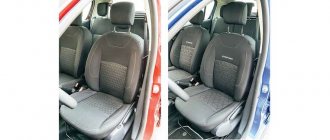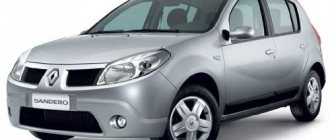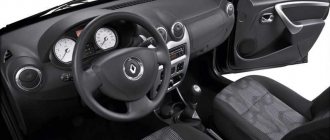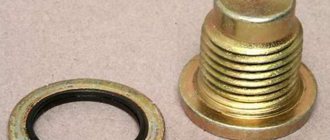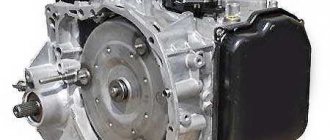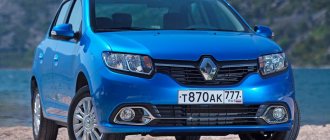103–3
Renault Sandero and Sandero Stepway.
The front seats have different upholstery fabrics, and in the pseudo-crossover there are STEPWAY inscriptions on the backs. Renault Sandero and Sandero Stepway. The front seats have different upholstery fabrics, and in the pseudo-crossover there are STEPWAY inscriptions on the backs.
The front seats have different upholstery fabrics, and in the pseudo-crossover there are STEPWAY inscriptions on the backs.
Car engines
The changes made as a result of the change of generations did not affect the Renault Sandero Stepway 2 engines. As before, the range of power units is limited to two models.
Both Renault Sandero Stepway engines have a volume of 1.6 liters, but produce different powers of 82 and 102 horsepower, and a volume of 1.6 liters, respectively.
The torque of the “junior” engine with a power of 82 horsepower and a volume of 1.6 liters is 124 newton meters, and an engine of 102 horsepower and a similar volume is 147 newton meters, respectively.
Acceleration of a 1.6-liter engine to 100 km/h in the version with an 8-valve engine (82 horsepower) is 11.9 seconds, according to the manufacturer, which is relatively acceptable in urban conditions. However, outside the city on country roads, overtaking will have to be calculated and adjusted. In the case of the “top” engine with 102 horsepower and a volume of 1.6 liters, this figure is 10.5 seconds - such dynamics are enough in any driving situation and, given the segment of the car, the acceleration dynamics are considered good.
What is the average fuel consumption of Renault Sandero Stepway 2 in a new body on a combined cycle? A 1.6-liter engine producing 82 horsepower produces 7.6 liters, and a 102-liter engine produces 7.1 liters of gasoline.
In terms of reliability, these units have proven themselves exclusively on the positive side. If timely routine maintenance is carried out, problems with engines will not occur during the declared service life of 200,000 kilometers. Consumables and spare parts for these units will pleasantly please the owner at a moderate cost relative to their direct competitors. There are cases where these engines have been maintained for more than 400,000 kilometers without major repairs, which, based on their technical characteristics, is an excellent result.
The biggest negative point of the Sandero Stepway 2 is the possible break of the timing belt, as a result of which the pistons meet the valves, and the latter bend. This breakdown entails significant financial costs, however, such cases are not widespread and if the belt replacement period is systematically observed, the chance of this malfunction occurring is minimal.
AND THEN WE FOUND A LARGE FIELD
For comparative runs we went out onto a snowy field. The ice crust formed due to the thaw slightly compacted the snow, the height of which varied from 150 to 300 mm. The standard Sandero is capable of walking through snow up to 180–200 mm deep, while the Sandero Stepway can cope with snow depths of 220–240 mm. It is important to remember that the Sandero's front bumper is abnormally fragile: it cannot withstand even light contact with slightly above average icy snow. Of course, it’s also a matter of the temperature, which dropped to -20 ºC on the day of the test, but it’s also a matter of cheap plastic. In general, you have to be extremely careful when driving this car in snowdrifts frozen over after the thaw.
103–1
The instrument clusters of the Sandero and Sandero Stepway hatchbacks differ little: on the Stepway the speedometer scale is decorated.
The instrument clusters of the Sandero and Sandero Stepway hatchbacks differ little: on the Stepway the speedometer scale is decorated.
The instrument clusters of the Sandero and Sandero Stepway hatchbacks differ little: on the Stepway the speedometer scale is decorated.
Sandero Stepway is noticeably more crossover in this sense: its front bumper is clearly better adapted to contact with frozen snow. As a result, its cross-country ability is indeed noticeably higher than that of a standard hatchback. But there are also general complaints about cars. A typical example: a car moves quite easily in the snow; There is a slight rise ahead, but the engine suddenly loses speed, and the car loses speed accordingly. “Pest” is a rude ESP that cannot be turned off. Of course, electronics are responsible for safety. But for a crossover, even a single-wheel drive one, the non-switchable stabilization system is by no means an assistant, since it does not allow driving over rough terrain with a slight slip. A sudden loss of traction interferes not only in deep snow, but also on wet grass - on any slippery surface! The manufacturer needs to think about introducing a switchable ESP, especially since it is not that difficult to implement. It’s no good when a machine itself kills its positive qualities. And we give the owners of these cars old-fashioned advice. If you are stuck in a harmless situation precisely because ESP strangled the engine at the most inopportune moment, remove the appropriate fuse to de-energize the system - and get out of captivity brazenly, unceremoniously, with juicy slipping. Just don't forget to put the fuse back in place later.
Specifications
If we take such an indicator as acceleration from zero to hundreds, then it is slightly inferior to the Logan and Sandero models. This is due to the presence of heavier 16-inch wheels, but for the sake of efficiency you can sacrifice half a second. The engines installed on the Sandero Stepway are of two types: 8 and 16 valves with a volume of 1600 cm3 (82 and 102 horsepower, respectively). The first is better suited for the city, and the second - for the highway.
Sandero Stepway 2015
Now about the driving sensations - they are very comfortable, perhaps a little stiffer than the Renault Sandero, but to give greater stability at speed with increased ground clearance, this is simply necessary. This solution was implemented through the use of a different anti-roll bar. Although even with such rigidity it is almost impossible to “break through” the suspension. But the increased ground clearance and tenacious front-wheel drive encourage small off-road exploits, although we do not recommend getting carried away with this.
Photo Renault Sandero
Defy authority
The good geometric parameters of the Sandero Stepway pseudo-crossover prompted us to experiment: we tried to improve the cross-country ability of a front-wheel drive car and even compare it with an all-wheel drive car with a similar engine base - and therefore we also took a Nissan Terrano to the test site. How can you improve patency with little blood? Of course, put on chains! We paid 4,000 rubles for a set of chains for the front wheels. And they didn’t regret it! The tall Sandero Stepway walked across the snowy field like a cheeky little tractor. It seems that now he will dig in and begin to thrash his front wheels helplessly, but no - he rows!
FROM SNOW TO ICE
The Stepway, which looked good to us in the field test, differs little from the regular Sandero on a flat road. In terms of maneuverability and controllability, the cars are almost indistinguishable from each other. True, Stepway is a little tougher on the highway. The suspension of the standard Sandero more confidently conceals large irregularities and even small snow and ice ripples formed on the asphalt after another snowfall and temperature change. But these are minor things. What is more significant is that the Sandero Stepway has positive qualities that the standard car does not have. Yes, Sandero Stepway is 42,000 rubles more expensive. It turns out about a thousand rubles for each additional millimeter of clearance. A bit expensive? But sometimes these millimeters are so important!
Increasing Sandero ground clearance - possible risks
First of all, before starting to look for solutions to the issue of increasing ground clearance, the driver should think about the possible risks. This step carries with it several tangible troubles for which the motorist must be prepared. Let's consider possible solutions to the problem of low clearance and the side effects they carry:
- Increasing ground clearance by replacing tires and wheels with similar ones with a larger diameter. This option allows you to “raise” the body above the road, but voids the manufacturer’s warranty on the car.
- Increasing ground clearance by replacing spacers on the upper supports of the suspension springs. Allows you to add about 3 cm to its height, but also voids the warranty.
- Increasing the ground clearance changes the picture of the car's rigidity and handling, as well as its dynamics, regardless of the method of increasing the height.
- The efficiency and accuracy of speed sensors is changing.
- The center of gravity changes, which leads to difficulties in driving at high speeds.
- The process of adjusting the wheel alignment becomes difficult.
- Possible increase in fuel consumption.
It is possible to recommend increasing clearance based on the above-mentioned number of side effects only at the owner’s own peril and risk. This procedure is justified for Sandero if the car is regularly used on bad roads and at low speeds.
Discuss on the Forum
106–2
Renault Sandero, Sandero Stepway, Lada Kalina, Lada Kalina Cross
Renault Sandero, Sandero Stepway, Lada Kalina, Lada Kalina Cross
P.S. A crossover can be created in many ways.
Relatively expensive - use passenger components and assemblies in combination with a newly developed body. An excellent example is the Renault Duster, built on Logan units. The second way is much simpler and cheaper: give a passenger car an off-road appearance, slightly increase the ground clearance and slightly modernize the mechanical components. This is exactly our case. Do such budget front-wheel drive sub-crossovers have a right to life? Undoubtedly! Especially if the original model is inexpensive and has high ground clearance from birth, modifications will not raise the price to the skies. In our opinion, Renault Sandero Stepway and Lada Kalina Cross are ideal examples of the successful implementation of such a concept. Renault Sandero or Sandero Stepway: a step higher
Even more extended fit
In the second version after the restyling of the Renault Sandero Stepway from 2014, the company's chief designers went further and increased the ground clearance by the same amount, that is, by another 20mm. And thus, in the new version the ground clearance was 195mm. This is a very significant and loud statement, capable of bringing the car, in terms of its seat height, into the class of full-fledged SUVs on the market. What other SUV can boast such clearance?
The process of raising the landing of the Renault Sandero Stepway was exactly the same as that used on the 1st generation of the car. The shock absorber struts themselves were lengthened, plus the springs, and all the calculated data were changed specifically for the ECU. Among other things, thanks to the high seating position and significantly widened wheel arches, the model now comes standard with 205/55 R 16 wheels with conventional 16-inch wheels.
Let us immediately note that the slightly increased width and also increased diameter help improve traction with the road surface and significantly increase cross-country ability. However, this is again an additional load on the power plant. But the French engineers did not think about providing a modernized engine, or at least removing power restrictions from all the standard engines presented. We also note that the clearance height of 19.5 cm is indicated for a fully loaded car, but if there is only one driver in the car during the trip, then the landing will be even higher.
